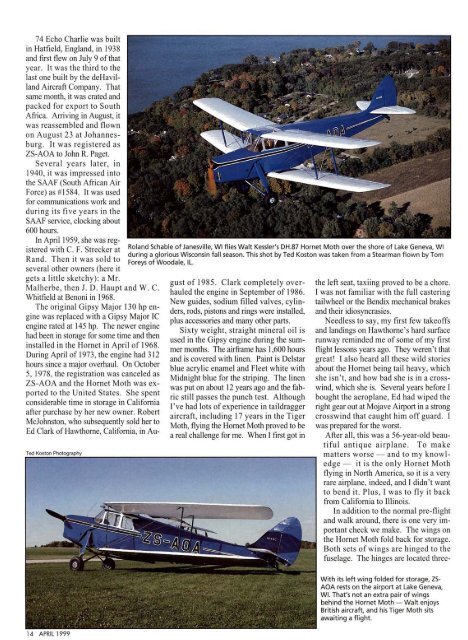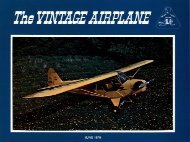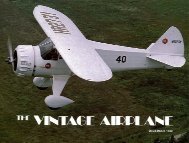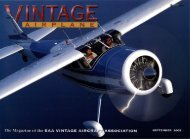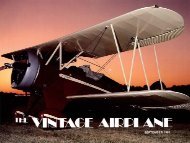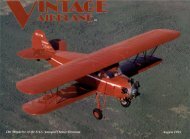VA Vol 27 No 4 April 1999 - Members Only
VA Vol 27 No 4 April 1999 - Members Only
VA Vol 27 No 4 April 1999 - Members Only
You also want an ePaper? Increase the reach of your titles
YUMPU automatically turns print PDFs into web optimized ePapers that Google loves.
74 Echo Charlie was built<br />
in Hatfield, England, in 1938<br />
and first flew on July 9 of that<br />
year. It was the third to the<br />
last one built by the deHavilland<br />
Aircraft Company. That<br />
same month, it was crated and<br />
packed for export to South<br />
Africa. Arriving in August, it<br />
was reassembled and flown<br />
on August 23 at Johannesburg.<br />
It was registered as<br />
ZS-AOA to John R. Paget.<br />
Several years later, in<br />
1940, it was impressed into<br />
the SAAF (South African Air<br />
Force) as #1584. It was used<br />
for communications work and<br />
during its five years in the<br />
SAAF service, clocking about<br />
600 hours.<br />
In <strong>April</strong> 1959, she was reg<br />
Roland Schable of Janesville, WI flies Walt Kessler's DH.87 Hornet Moth over the shore of Lake Geneva, WI<br />
istered with C. F. Strecker at during a glorious Wisconsin fall season. This shot by Ted Koston was taken from a Stearman flown by Tom<br />
Rand . Then it was sold to Foreys of Woodale, IL.<br />
several other owners (here it<br />
gets a little sketchy): a Mr.<br />
Malherbe, then J. D. Haupt and W. C.<br />
Whitfield at Benoni in 1968.<br />
The original Gipsy Major 130 hp engine<br />
was replaced with a Gipsy Major IC<br />
engine rated at 145 hp. The newer engine<br />
had been in storage for some time and then<br />
installed in the Hornet in <strong>April</strong> of 1968.<br />
During <strong>April</strong> of 1973, the engine had 312<br />
hours since a major overhaul. On October<br />
5, 1978, the registration was canceled as<br />
ZS-AOA and the Hornet Moth was exported<br />
to the United States. She spent<br />
considerable time in storage in California<br />
after purchase by her new owner. Robert<br />
McJohnston, who subsequently sold her to<br />
Ed Clark of Hawthorne, California, in Au<br />
14 APRIL <strong>1999</strong><br />
gust of 1985. Clark completely overhauled<br />
the engine in September of 1986.<br />
New guides, sodium filled valves, cylinders,<br />
rods, pistons and rings were installed,<br />
plus accessories and many other parts.<br />
Sixty weight, straight mineral oil is<br />
used in the Gipsy engine during the summer<br />
months. The airframe has 1,600 hours<br />
and is covered with linen. Paint is Delstar<br />
blue acrylic enamel and Fleet white with<br />
Midnight blue for the striping. The linen<br />
was put on about 12 years ago and the fabric<br />
still passes the punch test. Although<br />
I've had lots of experience in taildragger<br />
aircraft, including 17 years in the Tiger<br />
Moth, flying the Hornet Moth proved to be<br />
a real challenge for me. When I first got in<br />
the left seat, taxiing proved to be a chore.<br />
I was not familiar with the full castering<br />
tailwheel or the Bendix mechanical brakes<br />
and their idiosyncrasies.<br />
Needless to say, my first few takeoffs<br />
and landings on Hawthorne's hard surface<br />
runway reminded me of some of my first<br />
flight lessons years ago. They weren't that<br />
great! I also heard all these wild stories<br />
about the Hornet being tail heavy, which<br />
she isn't, and how bad she is in a crosswind,<br />
which she is. Several years before I<br />
bought the aeroplane, Ed had wiped the<br />
right gear out at Mojave Airport in a strong<br />
crosswind that caught him off guard . I<br />
was prepared for the worst.<br />
After all, this was a 56-year-old beautiful<br />
antique airplane. To make<br />
matters worse - and to my knowledge<br />
- it is the only Hornet Moth<br />
flying in <strong>No</strong>rth America, so it is a very<br />
rare airplane, indeed, and I didn't want<br />
to bend it. Plus, I was to fly it back<br />
from California to Illinois.<br />
In addition to the normal pre-flight<br />
and walk around, there is one very important<br />
check we make. The wings on<br />
the Hornet Moth fold back for storage.<br />
Both sets of wings are hinged to the<br />
fuselage. The hinges are located three-<br />
With its left wing folded for storage, ZS<br />
ADA rests on the airport at Lake Geneva,<br />
WI. That's not an extra pair of wings<br />
behind the Hornet Moth - Walt enjoys<br />
British aircraft, and his Tiger Moth sits<br />
awaiting a flight.


